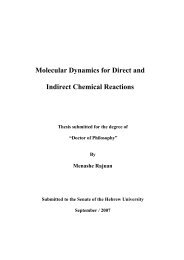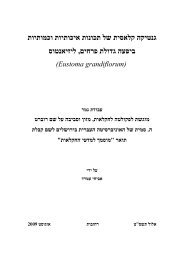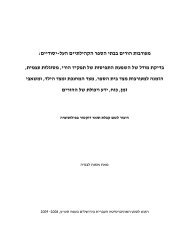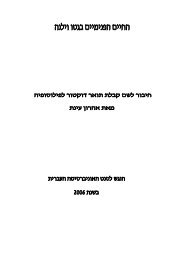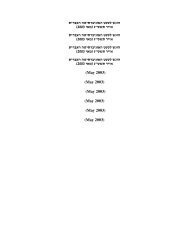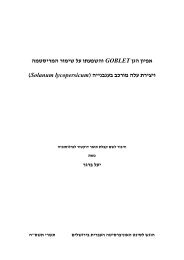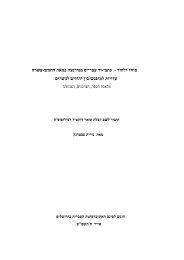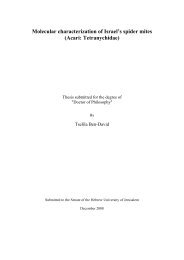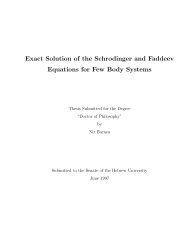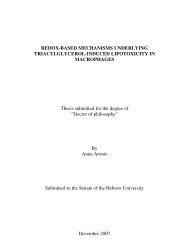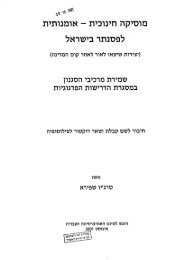Revealing the Mechanism of HSP104 Transcription Initiation in the ...
Revealing the Mechanism of HSP104 Transcription Initiation in the ...
Revealing the Mechanism of HSP104 Transcription Initiation in the ...
Create successful ePaper yourself
Turn your PDF publications into a flip-book with our unique Google optimized e-Paper software.
<strong>HSP104</strong> mRNA <strong>in</strong> different mutants show, <strong>in</strong>deed, <strong>the</strong> robustness <strong>of</strong> <strong>HSP104</strong><br />
transcription that is rarely affected by <strong>the</strong> absence <strong>of</strong> activators and o<strong>the</strong>r transcription<br />
factors.<br />
Through monitor<strong>in</strong>g <strong>the</strong> acetylation states <strong>of</strong> histones, we suggest that<br />
<strong>in</strong>duction <strong>of</strong> <strong>HSP104</strong> transcription requires that acetylated H3 and H4 molecules be<br />
absent. We observed that under optimal growth conditions all H4 histones on <strong>the</strong><br />
<strong>HSP104</strong> promoter are acetylated as well as major fractions <strong>of</strong> H3 histones. Under<br />
<strong>the</strong>se conditions, only <strong>in</strong> ras2∆ cells, concentrations <strong>of</strong> acetylated H3 and H4 are<br />
lower and <strong>the</strong> promoter is even occupied with non-acetylated H4. As <strong>in</strong> this stra<strong>in</strong> <strong>the</strong><br />
<strong>HSP104</strong> promoter is constitutively active, <strong>the</strong>re is clear correlation between promoter<br />
activity and non-acetylated histones. Current dogma <strong>of</strong> gene activation claims that<br />
acetylation <strong>of</strong> histones followed by <strong>the</strong> dissociation <strong>of</strong> nucleosomes from promoters is<br />
required for promoter activation (28, 49, 50). The case for <strong>HSP104</strong> is different.<br />
There is no global dissociation <strong>of</strong> histones from <strong>the</strong> promoter, but ra<strong>the</strong>r a specific<br />
dissociation <strong>of</strong> acetylated H3 molecules from nucleosomal structures and<br />
deacetylation <strong>of</strong> H4 molecules. Non-acetylated H3 prote<strong>in</strong>s rema<strong>in</strong> associated with<br />
nucleosomes even <strong>in</strong> response to heat shock and so do histone H4 molecules that are<br />
now not acetylated. Although not very common, <strong>the</strong> disassembly and deacetylation<br />
patterns we observe for <strong>HSP104</strong> <strong>in</strong> response to heat shock should not be that<br />
surpris<strong>in</strong>g. As described <strong>in</strong> Deckert et al (31) histone deacetylation can also lead to<br />
transcription <strong>in</strong>itiation <strong>of</strong> several stress-responsive genes. Also, a recent study also<br />
demonstrated that some promoters, namely GAL <strong>in</strong>duced promoters, are activated by<br />
histone deacetylation (31).<br />
However, our conclusion differs somewhat from that <strong>of</strong> Deckert and Struhl<br />
(31). These <strong>in</strong>vestigators also monitored a dramatic decrease <strong>in</strong> acetylated histones<br />
on <strong>the</strong> <strong>HSP104</strong> promoter <strong>in</strong> response to heat shock [18 fold decrease <strong>of</strong> acetylated H4<br />
and 10 fold decrease <strong>in</strong> acetylated H3 (31)]. Yet, as <strong>the</strong>re was some decrease <strong>in</strong> <strong>the</strong><br />
level <strong>of</strong> unacetylated H4 occupancy (30%) <strong>the</strong>y concluded that <strong>the</strong>re is altoge<strong>the</strong>r<br />
chromat<strong>in</strong> remodel<strong>in</strong>g or disassembly <strong>of</strong> <strong>the</strong> nucleosomes. We suggest that <strong>the</strong><br />
changes on <strong>the</strong> chromat<strong>in</strong> should not be taken as all-or-non activity (disassembly, or<br />
deacetylation). There seems to be a series <strong>of</strong> different events which we partly<br />
revealed; i.e., histones H4 are deacetylated, and acetylated H3 molecules are<br />
disassembled from nucleosomes. Also, <strong>the</strong>se changes are transient and reflect <strong>the</strong><br />
dynamic nature <strong>of</strong> <strong>the</strong> changes occurr<strong>in</strong>g on <strong>the</strong> promoter dur<strong>in</strong>g cont<strong>in</strong>uous exposure<br />
49



